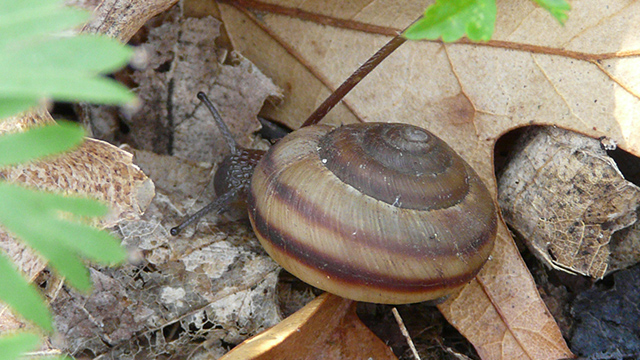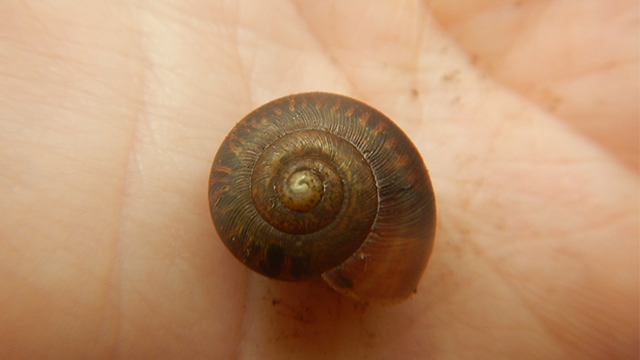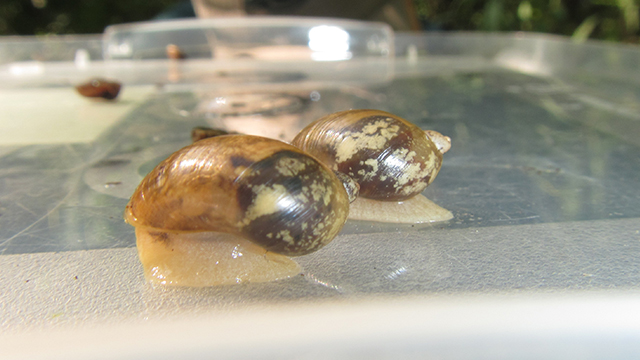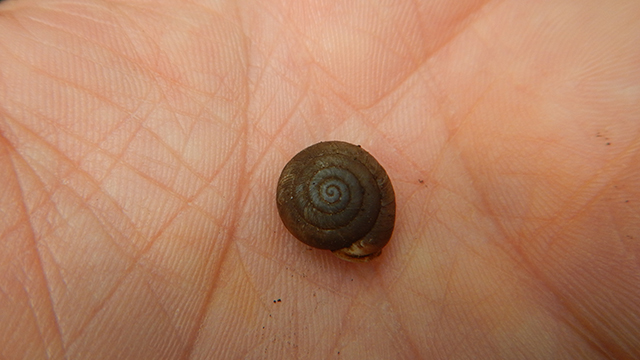Snails
Point Pelee National Park
Point Pelee is home to numerous species of snails. These animals are vital to the park’s ecosystem and our understanding of the natural world.

Some of the snails found at Point Pelee National Park
- Striped Whitelip (Webbhelix multilineata) – Species at risk
- Whitelip (Neohelix albolabris)
- Oval Ambersnail (Novisuccinea ovalis)
- Flamed Tigersnail (Anguispira alternata)
- Broad-banded Forestsnail (Allogona profunda) – Species at risk
- Eastern Banded Tigersnail (Aguispira kochi kochi) (Middle Island only) – Species at risk
- Shagreen snail(Inflectarius inflectus) (Middle Island only) – Species at risk




Why snails are important to ecosystems
Snails are often the unsung heroes of ecosystems! Snails are essential to the decomposition process by eating decaying and dead vegetation and leaving behind nutrient-rich feces in the soil. Also, once snails have died, their bodies and shells decompose and provide a source of calcium to the habitat. Their relationship to the soil is also helpful to us in other ways. By paying attention to the snail population of a place, we can learn what is to come for certain ecosystems. Snails can act as an indicator species as they are very sensitive to soil changes. For example, less snails in an area that previously had more could mean there is an ecological issue like the soil becoming more acidic. Keeping an eye on populations of species at risk like snails is one of the many ways we can monitor ecosystems in the park to help inform conservation projects.How we monitor snails in the park
At Point Pelee National Park, we have several survey plots, each about 2x2m2, that we monitor for snail populations. Here are the steps taken by Parks Canada Resource Conservation staff:
- Take a picture of the plot.
- Note important information about the plot: the type of plants, trees, flowers, and/or weeds, and the percentage of the land covered by vegetation, leaf litter, and open areas.
- Search for snails and slugs! We place all the ones we can find in a plastic container.
- Identify each individual snail or slug by recording their measurements (width, height, length, etc.), and photograph each of them.
- Lastly, the snails are returned to the plot in which they were found to continue their hard work keeping park ecosystems healthy!
This monitoring system allows Parks Canada to learn more about our species at risk snail populations and understand how the ecosystems at Point Pelee are changing.
Endangered snail species at Point Pelee National Park
In recent years there has been a growing movement led by researchers around the world to protect snails, from Fiji to Hawaii to New Zealand. Here in Canada, the Broad-banded Forestsnail and the Striped Whitelip, are endangered snail species that are now found only in Point Pelee National Park and a few sites in southern Ontario. Snails are especially vulnerable to extinction threats – their complex diet and habitat requirements make them hard to keep alive in captivity and vulnerable in the wild. Major threats include recreational activities, shoreline erosion, and predation by Wild Turkeys.
Habitat conservation and restoration efforts in the park help to protect these snails by ensuring they have suitable habitat. By removing invasive plant species, managing populations of hyperabundant wildlife species and supporting natural processes, park staff ensure the health of forest and woodland habitats that snails need.
Snail Facts – How many did you know?
- Some snail species are known to hibernate during the winter months.
- The trail of mucus left behind a moving snail reduces the friction between the snail and the ground and can help the snail avoid harm caused by moving over sharp objects in the soil.
- Snails do not have ears and therefore cannot hear; however, they do have eyes located on their upper tentacles protruding from their head.
- While mating, snail courtship can last anywhere from 2 to 12 hours.
- Terrestrial snails hatch from eggs and some individuals can have up to 430 hatchlings per year.
- Snails have many predators including rats, mice, beetles, turtles, salamanders and even some species of birds like wild turkeys.
Myth busting!
- Snail mucus is harmless to humans, contrary to popular belief.
- Snail shells are made up mostly of calcium carbonate. A snail’s shell grows with the snail and shell size can be used to determine the snail’s age. Snails do not trade out shells as many people think.
Differences between snails and slugs
Similar shape and slimy texture make many people believe that snails and slugs are the same type of animal. However, here are some differences that can help you distinguish the two gastropod molluscs and impress your friends and family with your knowledge!
| Characteristic | Snails | Slugs |
|---|---|---|
| Shells | Snails have coiled shells made of calcium carbonate located on the exterior of their body that they can retreat into when they sense danger | Slugs have no visible shells (but they may have small internal shells) |
| Size | Grows up to 10cm | The body of a slug usually grows larger (up to 15cm) |
| Lifespan | Snails usually only live 2-3 years in the wild | Slugs have a lifespan stretching from 1 year to 6 years |
| Behaviour | Snails tend to be on a constant hunt for food and have been known to be omnivorous when the opportunity arises | Slugs are nocturnal and prefer to feed on plant material at night |
| Habitat preferences | Snails prefer to inhabit soils and sand, live under rocks and leaves or on trees, and some species of snail are even aquatic | Slugs on the other hand look for dark areas rich in moisture that provide cooler temperatures to hide from the heat of the day |
Related links
- Date modified :